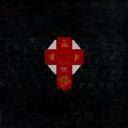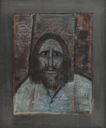Alex Basil Darais does not have an image.
Alex Basil Darais
(Venice, California, 1918 - 2007, Provo, Utah)
Alex Darais was born in 1918, in California, to Greek parents. He gave credit for his interest in fine arts to his parents, who exposed him to their Greek culture. Both the fine arts and Greek traditions were an important part of Darais' life. When he was serving in World War II, Darais received a paperback book of poems from the Red Cross titled The Pocket Book of Verse, Great English and American Poems, edited by M.E. Speare. He read these verses a great deal, and they inspired his life-long love of poetry. In 1946, back from the war, Alex Darais attended Brigham Young University and majored in art. He also began to write poetry. After graduating, he went to Claremont Graduate School in California. Having completed his master's degree, he returned to Brigham Young University in 1953 to teach art at the old Academy. As a designer and painter, he became one of BYU's most beloved and respected faculty members. Alex Darais was deeply influenced by cubist watercolorist John Marin and abstract artist Marsden Hartley, as well as by the oriental philosophies of Zen Buddhism. Darais often quoted from his favorite philosophers in classes and in casual conversation. During an interview, he said at his age, he's very aware of the passage of time, and he quoted two old Greek proverbs. "The only permanent thing is change," and "You can't step in the same river twice." Darais said his art works come in response to feelings and experiences; they are intimate and involved. As a teacher and father of seven, he found time constraints required him to do his art "on the run." He changed from oils to gauche and acrylics so he could allow his art "to spill out onto the canvas." This change in media gave his art a sense of expediency and spontaneity that accurately reflected his feelings. Alex always had an exquisite eye for design, especially for pleasing and interesting patterns hidden in everyday scenes and objects. He found aesthetic value in shapes most people never notice. Once, at a wedding reception of a friend, he had someone stand on a chair to take a photograph of the intriguing shape of a spill on a tablecloth. As a teacher, he worked to awaken in his students a sensitivity to the infinite beauties all around them, as well as to the design of utilitarian objects. He was once asked to no longer bring his design class to a local department store because the department manager was afraid the students' outspoken critiques of the dinnerware and flatware would discourage customers. Darais constantly pointed out both interesting shapes and also poor design to his students and to anyone who happened to be around him. He asked everyone to think and to analyze whether objects fit, (How would that spoon fit your hand? How would it feel in your mouth?) whether the objects are comfortable, are durable, and are practical. Graphic design interested Alex as well. His best-known projects are probably the Bonneville Bank and Sundance logos. His design orientation carries over into his approach to painting. He made no attempt to create a three-dimensional picture plane, but used a straightforward, two-dimensional expression of his ideas and feelings. His paintings are graphic images. Besides his innate interest in design, Darais' love of poetry helped inspire his art, as well as, his art inspiring his poetry. Darais painted "Over Three Billion Served" in 1974, and later in 1986, he wrote the poem "Beef." (The poem is found in his book "Little Bird, Selected Poems and Paintings" available through BYU's Museum of Art) Conversely, he wrote the poem "Dark Continent" in 1965, after reading a news story in the Provo Daily Herald ; and in 1969, painted a work with the same title, Dark Continent. The painting Over Three Billion Served was painted after Darais noticed a red cross lying on the ground in a parking lot. When he picked it up, the McDonalds' "Big Mac" container "immediately conjured up an image with religious connotations." Thoughts of all the animals that had been slaughtered to make hamburgers came to mind, and he could envision one cow that was trying to break out of the herd. The images also were tied to personal and powerful religious feelings about sacrifice. Out of these feelings came a piece of art portraying both religious values and social criticism. Darais enjoyed painting and teaching art, but shied away from promoting or selling his art. His wife said each art work was like a child to him, and he couldn't bear to discuss price. He gave a few pieces to area museums, and his seven children each picked out their favorites before his death. In 1990, Darais published a book of poetry and art: "Little Bird, Selected Poems and Paintings". The book was the result of more than a decade of work. In April of 1995, a retrospective exhibit of his art work was displayed at the new Museum of Art on the Brigham Young University campus. Darais passed away in his Provo, Utah home on August 8, 2007.
(Venice, California, 1918 - 2007, Provo, Utah)
Alex Darais was born in 1918, in California, to Greek parents. He gave credit for his interest in fine arts to his parents, who exposed him to their Greek culture. Both the fine arts and Greek traditions were an important part of Darais' life. When he was serving in World War II, Darais received a paperback book of poems from the Red Cross titled The Pocket Book of Verse, Great English and American Poems, edited by M.E. Speare. He read these verses a great deal, and they inspired his life-long love of poetry. In 1946, back from the war, Alex Darais attended Brigham Young University and majored in art. He also began to write poetry. After graduating, he went to Claremont Graduate School in California. Having completed his master's degree, he returned to Brigham Young University in 1953 to teach art at the old Academy. As a designer and painter, he became one of BYU's most beloved and respected faculty members. Alex Darais was deeply influenced by cubist watercolorist John Marin and abstract artist Marsden Hartley, as well as by the oriental philosophies of Zen Buddhism. Darais often quoted from his favorite philosophers in classes and in casual conversation. During an interview, he said at his age, he's very aware of the passage of time, and he quoted two old Greek proverbs. "The only permanent thing is change," and "You can't step in the same river twice." Darais said his art works come in response to feelings and experiences; they are intimate and involved. As a teacher and father of seven, he found time constraints required him to do his art "on the run." He changed from oils to gauche and acrylics so he could allow his art "to spill out onto the canvas." This change in media gave his art a sense of expediency and spontaneity that accurately reflected his feelings. Alex always had an exquisite eye for design, especially for pleasing and interesting patterns hidden in everyday scenes and objects. He found aesthetic value in shapes most people never notice. Once, at a wedding reception of a friend, he had someone stand on a chair to take a photograph of the intriguing shape of a spill on a tablecloth. As a teacher, he worked to awaken in his students a sensitivity to the infinite beauties all around them, as well as to the design of utilitarian objects. He was once asked to no longer bring his design class to a local department store because the department manager was afraid the students' outspoken critiques of the dinnerware and flatware would discourage customers. Darais constantly pointed out both interesting shapes and also poor design to his students and to anyone who happened to be around him. He asked everyone to think and to analyze whether objects fit, (How would that spoon fit your hand? How would it feel in your mouth?) whether the objects are comfortable, are durable, and are practical. Graphic design interested Alex as well. His best-known projects are probably the Bonneville Bank and Sundance logos. His design orientation carries over into his approach to painting. He made no attempt to create a three-dimensional picture plane, but used a straightforward, two-dimensional expression of his ideas and feelings. His paintings are graphic images. Besides his innate interest in design, Darais' love of poetry helped inspire his art, as well as, his art inspiring his poetry. Darais painted "Over Three Billion Served" in 1974, and later in 1986, he wrote the poem "Beef." (The poem is found in his book "Little Bird, Selected Poems and Paintings" available through BYU's Museum of Art) Conversely, he wrote the poem "Dark Continent" in 1965, after reading a news story in the Provo Daily Herald ; and in 1969, painted a work with the same title, Dark Continent. The painting Over Three Billion Served was painted after Darais noticed a red cross lying on the ground in a parking lot. When he picked it up, the McDonalds' "Big Mac" container "immediately conjured up an image with religious connotations." Thoughts of all the animals that had been slaughtered to make hamburgers came to mind, and he could envision one cow that was trying to break out of the herd. The images also were tied to personal and powerful religious feelings about sacrifice. Out of these feelings came a piece of art portraying both religious values and social criticism. Darais enjoyed painting and teaching art, but shied away from promoting or selling his art. His wife said each art work was like a child to him, and he couldn't bear to discuss price. He gave a few pieces to area museums, and his seven children each picked out their favorites before his death. In 1990, Darais published a book of poetry and art: "Little Bird, Selected Poems and Paintings". The book was the result of more than a decade of work. In April of 1995, a retrospective exhibit of his art work was displayed at the new Museum of Art on the Brigham Young University campus. Darais passed away in his Provo, Utah home on August 8, 2007.
Artist Objects


